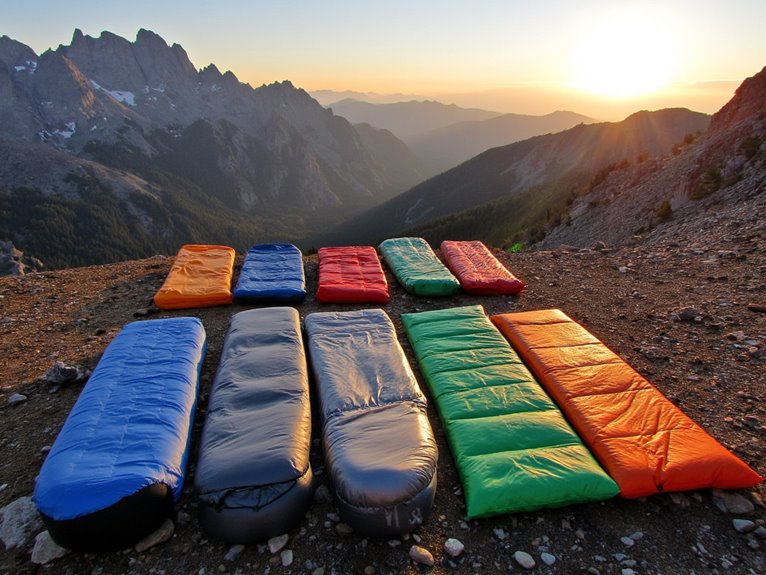What Is Usually in a Survival Pack?
A well-stocked survival pack typically includes essential items across seven critical categories. Shelter and warmth supplies include a tent, sleeping bag, and fire starter kit. Water purification and storage items consist of a water filter, purification tablets, and a water storage container. First aid and hygiene essentials include a first aid kit, toilet paper, and hand sanitizer. Food and nutrition supplies feature non-perishable items, energy-rich snacks, and a portable stove. Navigation and orientation tools include a compass, topographic maps, and a GPS device. Communication and signaling devices, personal protection and safety items, and multi-tool and fire starters complete the essential contents. By understanding these critical components, you'll be better equipped to build a thorough survival pack that meets your specific needs.
We are supported by our audience. When you purchase through links on our site, we may earn an affiliate commission, at no extra cost for you. Learn more. Last update on 6th January 2026 / Images from Amazon Product Advertising API.
Shelter and Warmth Essentials
Adequate shelter and warmth are essential components of a survival pack, as they provide protection from the elements and help maintain a stable body temperature. A lightweight and waterproof tent or tarpaulin is a must-have, along with a warm and compact sleeping bag or blanket. A space blanket or emergency bivvy sack can also be included as a backup option. Additionally, a warm hat and gloves can help prevent heat loss, while a fire starter kit or waterproof matches can aid in starting a fire to keep warm. These shelter and warmth essentials will help guarantee survival in harsh outdoor environments.
Water Purification and Storage
Having established a safe and warm shelter, the next imperative is to secure a reliable source of clean drinking water, as dehydration can set in rapidly in survival situations, making water purification and storage a paramount component of a survival pack. A water filter or purification tablets can effectively eliminate bacteria, viruses, and other contaminants from questionable water sources. A water storage container, such as a collapsible water bottle or hydration bladder, is also essential for storing and carrying purified water. Additionally, a water collection system, like a water condenser or solar still, can aid in harvesting water from unconventional sources. Including these items in a survival pack provides access to safe drinking water, a fundamental component of survival.
First Aid and Hygiene
When assembling a survival pack, it is essential to include essential items that address First Aid and Hygiene needs. A well-stocked first aid kit should contain wound care essentials, such as bandages, antiseptic wipes, and pain relievers. Additionally, basic hygiene items, like toilet paper, hand sanitizer, and biodegradable soap, along with personal sanitation tools, such as a portable toilet and feminine hygiene products, are necessary for maintaining personal health and preventing the spread of illness.
Wound Care Essentials
Proper wound care is essential in preventing infection, promoting healing, and reducing the risk of long-term damage or scarring. A well-stocked survival pack should include essential wound care items to facilitate prompt and effective treatment. Antiseptic wipes and antibacterial ointment are must-haves for cleaning and disinfecting wounds. Gauze pads and rolls provide a sterile dressing for covering wounds, while medical tape secures the dressing in place. Additionally, including a pair of tweezers and scissors allows for the removal of debris and dressing changes. A small supply of pain relievers, such as acetaminophen or ibuprofen, can also be included to help manage discomfort. These essentials will aid in providing basic wound care and promote a speedy recovery in emergency situations.
Basic Hygiene Items
What role do personal hygiene items play in maintaining health and preventing the spread of illnesses in emergency situations? They play a vital role. In a survival pack, basic hygiene items are essential for maintaining personal cleanliness, preventing the spread of diseases, and promoting overall health. These items typically include toilet paper, hand sanitizer, biodegradable soap, toothbrush, toothpaste, and feminine hygiene products. In an emergency, these items may seem trivial, but they can substantially impact one's health and well-being. By including these basic hygiene items in a survival pack, individuals can reduce the risk of illnesses and maintain a sense of dignity and comfort in crisis situations.
Personal Sanitation Tools
In addition to basic hygiene items, a well-stocked survival pack should also include personal sanitation tools that enable individuals to maintain cleanliness and address minor injuries in emergency situations. These tools are essential for preventing the spread of infections and promoting overall health in challenging environments.
Some essential personal sanitation tools to include in your survival pack are:
- Antiseptic wipes for cleaning wounds and preventing infections.
- Gloves for protecting your hands from bodily fluids and contaminants.
- Hand sanitizer for maintaining hand hygiene when water is scarce.
- Biodegradable soap for washing hands and body in emergency situations.
Food and Nutrition Supplies
When assembling a survival pack, prioritizing food and nutrition supplies that provide sustenance and energy is vital. Non-perishable items, such as canned goods and dried fruits, are essential inclusions, as they can withstand extreme temperatures and remain edible for extended periods. Additionally, energy-rich snacks like nuts, seeds, and dried meats can help maintain physical and mental performance in high-stress situations.
Non-Perishable Items
Stocking a survival pack with non-perishable food items that provide sustenance and energy is vital to maintaining health and morale during an emergency situation. These items should be compact, lightweight, and have a long shelf life. Including a variety of non-perishable items can help guarantee that you have a reliable source of nutrition in case of an emergency.
Some essential non-perishable items to include in your survival pack are:
- Dried fruits and nuts
- Canned goods (vegetables, meats, and soups)
- Energy-rich grains (oats, rice, and quinoa)
- Ready-to-eat meals (such as MREs or dehydrated meals)
Remember to choose items that are easy to prepare, requiring minimal cooking or water.
Energy-Rich Snacks
Beyond non-perishable staples, incorporating energy-rich snacks into your survival pack can provide a quick and convenient boost of sustenance during an emergency. These snacks are designed to provide a rapid energy boost, helping to sustain you until more substantial food sources become available. Examples of energy-rich snacks include nuts, dried fruits, and energy bars. When selecting snacks, prioritize those high in protein, complex carbohydrates, and healthy fats. Avoid sugary or salty snacks that can lead to energy crashes and dehydration. Opt for compact, lightweight options that won't spoil easily, such as freeze-dried fruits or energy chews. Remember to rotate your snacks regularly to guarantee they remain fresh and effective.
Accurate navigation and orientation are essential survival skills, as they enable individuals to traverse unfamiliar territories efficiently and avoid potentially life-threatening situations. Having the right tools can make all the difference between finding your way back to safety and getting lost in the wilderness. A well-stocked survival pack should include the following navigation and orientation tools:
- Compass: A reliable compass helps you determine direction and navigate through unfamiliar terrain.
- Maps: Topographic maps provide detailed information on terrain, water sources, and potential hazards.
- GPS Device: A handheld GPS device can provide precise location coordinates and guide you back to safety.
- Celestial Navigation Tools: A sextant or star chart can help you navigate using celestial bodies, even without electronic devices.
These tools can substantially improve your chances of survival in the wilderness.
Communication and Signaling Devices
Effective communication and signaling are essential in a survival situation, as they enable individuals to convey their location and status to potential rescuers. A survival pack should include devices that facilitate communication and signaling, such as a two-way radio or a satellite phone, which allow individuals to send and receive messages. Whistle signals are also crucial, as they can be used to signal for help over long distances. Additionally, including a mirror or other reflective surfaces can aid in signaling during the day. A signaling flare or pyrotechnic devices can be used to signal for help at night or in low-visibility conditions. These devices can substantially increase the chances of being rescued in a timely manner.
Personal Protection and Safety
In addition to facilitating communication and signaling, a well-equipped survival pack should also prioritize personal protection and safety, as unforeseen threats can arise in the wilderness. A prudent survivalist should be prepared to defend themselves and protect against environmental hazards.
Some essential items to include in your survival pack for personal protection and safety are:
- Pepper spray or a similar deterrent for fending off wild animals or hostile humans.
- Snake bite kit and knowledge of how to use it, as snake bites can be deadly.
- Sunscreen and insect repellent to protect against harsh weather conditions and disease-carrying insects.
- First aid kit with basic medical supplies, including bandages, antiseptic wipes, and pain relievers.
Multi-Tool and Fire Starters
A reliable multi-tool and fire starters are essential components of a well-stocked survival pack, as they can help you overcome obstacles, create shelter, and start a fire to stay warm and signal for help. A multi-tool should include features such as scissors, pliers, knives, and a can opener. Fire starters, such as waterproof matches, lighters, or ferrocerium rods, can help you ignite a fire even in damp or wet conditions. These tools can also be used for signaling for help by creating smoke during the day or a fire at night. Having a reliable multi-tool and fire starters in your survival pack can greatly increase your chances of survival in an emergency situation.



